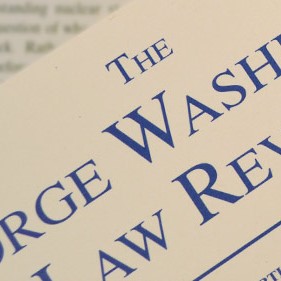Gia B. Lee · February 2008
76 GEO. WASH. L. REV. 197 (2008)
When congressional committees sought information relating to the U.S. attorney firings and Hurricane Katrina, when the 9/11 Commission called for the National Security Advisor to testify, when Senators requested memoranda authored by judicial nominees while working as Department of Justice and White House lawyers, when the General Accounting Office and two nonprofit groups asked for information on the meetings of the Vice President’s energy policy task force, and on numerous other occasions, the current Bush administration provided the same response: the requested information involves internal deliberations, and its disclosure would have a chilling effect on full and frank communications. The White House accordingly denied the requests, arguing that maintaining the deliberations’ confidentiality would ensure the “unfettered” or “unvarnished” advice necessary to presidential decision making.
It is understandable that presidential administrations routinely rely on that argument. The Supreme Court has validated the reasoning in United States v. Nixon (Nixon I), citing the need to promote candor as the primary basis for protecting presidential communications under the executive privilege. As the Court stated, “[h]uman experience teaches that those who expect public dissemination of their remarks may well temper candor with concern for appearances and for their own interests to the detriment of the decisionmaking process.” As a political matter, the claim is intuitively appealing. Indeed, that emphasis on candor and decision making provides some justification for confidentiality in a broad variety of contexts, both inside and outside government, including jury and judicial deliberations, academic and medical peer review, police review boards, and the attorney-client and doctor-patient privileges.
But how robust, really, is that argument? Is confidentiality necessary for full and frank communications among the President and his advisors? And if so, do those candid communications lead to better decisions or decision-making processes? Put another way, does the interest in encouraging full and frank communications provide a substantial reason for shielding presidential deliberations from outside scrutiny? Despite the voluminous literature on executive privilege, and the fact that these issues underlie the Supreme Court’s principal justification for the privilege, these questions have received remarkably little attention.
This Article examines this candor-based justification for maintaining the confidentiality of deliberations, involving the President or his immediate White House advisors, that underlies publicly acknowledged policies. The Article argues that, from a constitutional perspective, this commonsense assumption is significantly incomplete and, as a result, overstates the strength of the President’s confidentiality interest. It fails to take into account the qualified and contingent nature of the President’s need for confidentiality. The extent to which the lack of confidentiality will chill presidential deliberations is neither fixed nor always substantial, but turns on a range of factors, including the information under discussion and the specifics of the proposed disclosure. It also overstates the likelihood that confidentiality-induced candor will lead to better decisions. It stresses one potentially salutary effect of confidentiality—reducing speaker inhibitions—while ignoring other, more troubling consequences.
The Article proceeds in three parts. Part I reviews the constitutional status of the President’s confidentiality interest. Briefly charting the evolution of the Supreme Court’s treatment of this interest, Part I details how the Court’s decision in Cheney altered the constitutional landscape established by the two Nixon cases of the Watergate era. Part II critically assesses the interest. It identifies the variable need for, and the potential risks of, maintaining confidential presidential deliberations. Finally, Part III turns to the practical implications of that assessment and sets forth the differentiation approach. In doing so, it clarifies the distinctiveness of this approach from those in Cheney and the Nixon cases. A brief conclusion follows.

